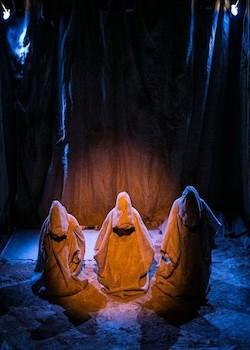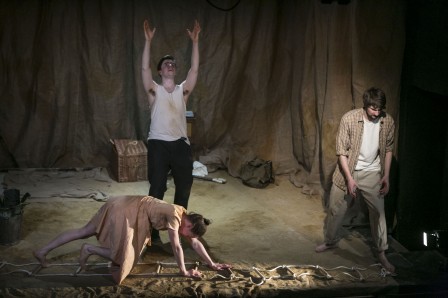An interview with Micha Colombo

Adapted as a play and directed by Micha Colombo
Theatre503
London, 14 -18 January 2014
Interview by Susan Meehan
Kagami Theatre hopes to tour Woman in the Dunes more widely around the UK in 2014 and is currently preparing for a second round of fundraising in order to make the proposed tour possible. The Daiwa Anglo-Japanese Foundation supported the London theatre premiere which received extremely good reviews. It was certainly packed on the last night, when I went to see it and I know that it sold out on its first evening as well. I had the pleasure of congratulating and also interviewing Micha Colombo on 24 January, soon after her run at the Theatre503 had come to an end.
Susan: You studied Japanese at Cambridge – what brought you to directing and acting?
Micha: I have always loved drama from an early age – from being a regular participant in my local village panto as a child, through school plays and lots of student drama while at Cambridge. After university, I initially went into a more corporate role in marketing, but eventually realised my heart was still in theatre, so I made the choice to pursue it professionally. I took the plunge, left my job and got a place at one of the big London drama schools, the Academy of Live & Recorded Arts (ALRA), to train professionally as an actor. While there, and since graduating, I started to realise that my love of theatre might extend beyond performance to include directing and writing too. I’m still pretty early on in my career in theatre, so time will tell where it takes me.
Susan: You founded the Kagami Theatre – can you tell us about this venture?
Micha: The most obvious answer is that my university studies and time spent in Japan have instilled a long-term love for Japan and broader East Asia (I have also lived and worked in Beijing) and so I want to do my bit to share and showcase a culture that I have found inspiring over the years. There is also another more nuanced reason that I started Kagami Theatre. I am by no means an expert in Japanese theatre or in its representation in the UK (yet!) but from a personal, anecdotal perspective I sometimes get the impression that Japanese culture is exoticised in the UK and I feel this can be a little reductive. While admittedly, there are times when it is very useful and interesting to explore our differences and what makes a culture unique, I do however feel that there is also a need to emphasise the universality, the humanity that exists across all cultures. Difference is always appealing for novelty’s sake, but I believe theatre has a powerful role to play in building empathy and helping us make sense of the human condition collectively. So I hope with Kagami Theatre to provide some alternative perspectives on Japanese culture through its ideas and stories rather than its aesthetic.
Susan: Why do you think Woman in the Dunes resonated with the audience at Theatre503?
Micha: As I mentioned in the previous answer, we really tried with Woman in the Dunes to focus on themes that resonate with contemporary audiences in the UK. We live in a global economy that has inequality at its heart. When national economies ‘develop’ and ‘progress’ this doesn’t necessarily translate to every individual in equal measure. For me, one of the powerful points of the story was the exploration of how people survive when they effectively get left behind by society. Each of the characters in the story is trying to make sense of the harsh conditions in which they find themselves and trying to carve out a normality within that. The story really challenges our notions of purpose and achievement and we received a lot of audience feedback that this exploration of why we work struck a real chord with people.
Susan: Is Abe Kobo your favourite author?
Micha: I am terrible at choosing favourites I’m afraid, I think it’s impossible as different writers give you different things! But I think Abe Kobo was a truly visionary person. I absolutely loved reading more of his work and researching his processes and ideas in preparation for the show. He has been a real inspiration to me and I’m sure I will create more work related to him in future.
Susan: What was most difficult about this particular project? What was the easiest aspect?
Micha: There were lots of challenges about this project, mainly practical. We had to create this production on a very small budget generously funded by the Daiwa Anglo-Japanese Foundation. Without that support, this project may not have been possible. Budget restrictions meant we had to be creative with our production design and seek to keep costs absolutely minimal across all aspects of the production without sacrificing quality. Also, there were some staging challenges that were pretty daunting – the main one being how to represent a 20 metre deep pit of sand and the movement of props and people in and out of said pit when staging the show in a 5m by 5m square studio space! The easiest aspect, or perhaps one of the most enjoyable was gathering the team together – actors, designers, stage manager. I was so lucky to find a fantastic team of really creative people who also loved the story and wanted to help bring it to life. I thought it might be tricky finding others who were as excited as me about the piece, but in fact, I had a wealth of great talent to choose from.
Susan: How different was the first performance on Tuesday, 11 January from the last on 18 January?
Micha: We only had a short first run this time but even then the show shifted and evolved over just 5 nights of public performance. I felt it gained pace and the actors really started to ground their characters and make the dialogue come to life. It takes a live audience to make you realise what moments really zing and which need further work. There is always room for improvement, especially since I am relatively new to the game, so I will be editing the script and making some structural changes if we manage to secure funding for another phase of touring the show.
Susan: What other Japanese authors/playwrights have influenced you?
Micha: Lots! I have always enjoyed reading Mishima and Tanizaki Jun’ichiro, I went to a great rehearsed reading of Getting Lost by Maeda Shiro at the Japan Foundation a few years back which sparked a few thoughts, I loved Sei Shonagon when I read her at university. I also think there is a rich tradition of folk tales in Japan that are a real treasure trove of exciting stories.
Susan: What are you aiming to do next?
Micha: If possible, I would love to share Woman in the Dunes with a broader audience via a tour, but this is all subject to funding. I am now starting to think about Kagami Theatre’s next project. I have a feeling it might be something devised this time, perhaps around some of those great folk tales I mentioned, but we’ll see.
Susan: Which play has impressed you most over the last few years and why?
Micha: A production of Chekhov’s Three Sisters by Benedict Andrews. This was Chekhov like I’d never seen it before and packed a real punch. The design was startling and an integral part of the action rather than simply acting as a backdrop, and included a huge mound of earth and a stage of raised blocks that were progressively cleared away throughout the second half. The dialogue felt alive and contemporary so that I had a strong sense of empathy with the characters rather than seeing them as museum pieces. It was emotionally vibrant.
You can learn more about Kagami Theatre here. Images in article: © Roberto Zampino 2014

